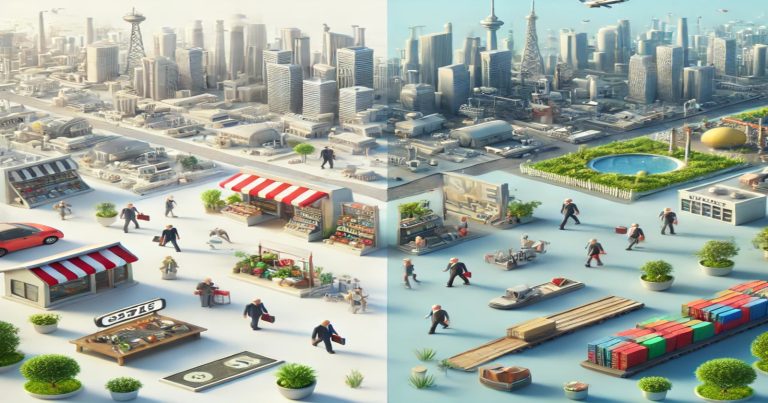Microeconomics and macroeconomics are the two main strands into which economics can be broadly divided. Microeconomics is the study of individual economic units, such as consumers, firms, and markets. Macroeconomics focuses on the economy as a whole, dealing with subjects such as national income, inflation, unemployment, and economic growth. Understanding the distinction between micro & macro economics helps in analyzing how small-scale decisions affect the larger economy and vice versa. Here, we shall discuss their definitions, components, important differences, and real-life applications in detail.
Difference Between Micro and Macro Economics
The main distinction is that micro deals on the function of individual and firm in the market. It is concerned with aggregates such as national income, volume of trade and trade balance in the case of macro economics. Microeconomics analyzes how the decisions and behavior of people, firms and households affect supply and demand for goods and services. It determines prices, and how prices, in turn, determine the quantity supplied and quantity demanded of goods and services. Macroeconomics, on the other hand, focuses on the whole economy, including the big picture of the economy concerning inflation, national income, employment, and the totality of economic growth. Microeconomics describes the minute pieces of the economy. Macroeconomics explains the entire economy and the issues related to it at the national or even international level. The two are linked, and both are necessary to give a full picture of economic life.
| Basis of Difference | Microeconomics | Macroeconomics |
| Scope | Deals with individuals, firms, and specific markets. | Deals with the economy as a whole, including national issues. |
| Focus Area | Studies supply, demand, pricing, production, and consumer behavior. | Studies GDP, inflation, unemployment, and fiscal and monetary policies. |
| Objective | Achieve market equilibrium and efficient resource allocation. | Achieve economic growth, stability, and full employment. |
| Key Variables | Individual prices, wages, or income of households or firms. | Achieve economic growth, stability, and full employment. |
| Examples | Price of a mobile phone, hiring in a company, consumer choice. | Inflation rate in India, the country’s GDP growth, and the national unemployment rate. |
What is Microeconomics?
Microeconomics is the branch of economics that focuses on the economic behavior of individual decision-making and the firm in dealing with individual markets. This area of economics deals with the how and why economic agents choose between available scarce resources in order to satisfy their wants or make a profit. Microeconomics is indeed relevant as we’re to see how people spend their money (consumer behavior), which strategies these firms follow, and how markets behave overall. The difference between micro and macroeconomics helps to understand how markets work, how prices are determined, how taxes affect businesses, and how people maximize their utility.
Individual Behavior Analysis
- Microeconomics is about how people make choices with resources.
- It analyzes the conditions of supply and demand in markets.
Market Equilibrium
- Describes how supply at a given price equals demand.
- Illustrates the reasons for changes in prices and quantities.
- Analyzes competition among firms.
Resource Allocation
- Analysis the way in which society allocates its resources in order to produce various goods and services.
- Fixates on efficiency and getting the most out of production.
What are the Different Components of Microeconomics?
Microeconomics is made up of several key components that explain the acts of individuals and companies within markets. These are the elements at the basis of the study of markets and the economic agents.
Demand and Supply
- Demand tells us how much consumers would want a product at different prices.
- Supply refers to the quantity of a product that producers are willing to sell at different prices.
- The market price is the price at which the quantity demanded equals the quantity supplied.
| Component | Meaning |
| Demand | Consumer’s willingness to buy |
| Supply | Producer’s willingness to sell |
| Equillibrium | Where demand equals supply |
Whether you are taking notes or searching for a “difference between micro and macro economics pdf,” you are going to have to go more in depth with demand supply analysis.
Price Elasticity
- Price elasticity gauges how much quantity demanded or supplied responds to price change.
- When elasticity is higher, consumers shift quickly with price changes.
- Elasticity is crucial for pricing strategies in businesses.
Consumer Behavior
- Investigates how people make consumer decisions.
- Entails the comprehension of values, preferences and budget constraints.
- It describes why consumers prefer one product over another.
Production and Costs
- Examines how businesses determine how much to produce depending on the cost.
- Includes topics like: Marginal Cost & Average Cost
- Economies of scales
What is Macroeconomics?
Macroeconomics is the study of the economy as a whole, including domestic output, level of employment, price level, and rate of growth. It works with collective indicators, i.e., with the systemic interdependence that several interacting sectors look for.
Aggregate Analysis
- Covers domestic and foreign economics.
- Add up total spending, total saving and total investment.
Growth and development
- Studies how countries develop over time.
- Examines improvements in the quality of life.
Policy Formulation
- Assists governments in forming fiscal and monetary policies.
- Regulations Invoke policies that control inflation, unemployment, GDP growth.
What are Different Components of Macroeconomics?
Macro components present details about the large segments that constitute an entire economy and collectively impact an economy’s overall effectiveness and, as a result, policy decisions. They guide economic policy toward stability and long-run growth.
- Gross Domestic Product (GDP): The combined value of all goods and services produced in a country over a certain time period, used to assess the nation’s economic health. Total value of goods and services produced in a country.
- Inflation: The increase in the general price level of goods and services in an economy. Assists in comparing purchasing power and the cost of living.
- Unemployment: Analyzes the amounts and the reasons for unemployment among people. It affects income, consumer spending and economic growth overall.
- Fiscal and Monetary Policies: Fiscal policy is the use of government spending and taxation to impact economic activity. Monetary policy is targeted at the control of the money supply and interest rates in order to achieve economic stability.
How are Microeconomics and Macroeconomics Interdependent on Each Other?
Micro and macroeconomics remain highly interrelated, although separate in many respects. In all cases, what happens in the macro does impact the micro, and vice versa.
Micro-Level Impact on Macro
- National economic behavior is just the sum of many individual business and consumer decisions.
- For instance an increase in the demand of automobiles will boost industrial production as well as GDP.
Micro and Macro-level Factors
- Inflation or recession determines how much the individual can spend.
- Fluctuations in interest rates have an effect on borrowing and saving patterns.
Policy Feedback Loop
- Government policies, including those in the form of tax cuts or checks in the mail, alter consumer behavior.
- Altered consumer habits have implications for the economy as a whole.
Difference Between Micro and Macro Economics FAQs
1. What are the 5 differences between micro and macro economy?
Microeconomics examines individual people and individual firms. Macroeconomics examines entire economies. Micro looks at price and output in individual markets. Macro studies inflation, GDP, unemployment, and policy.
2. What is the difference between micro and macro economic environment?
Microeconomic situation includes consumers, producers, rivals and the type of market that exist in the market. Macroeconomic environment includes national income, inflation, taxation, interest rate and economic growth etc.
3. What are micro and macro variables?
Micro variables are variables that can take on atomic characteristics such as demand, supply, and cost. Macro variables are aggregates like GDP, inflation rates, unemployment and money supply.
4. What is the distinction between micro and macro states?
Microstates concentrate on particular, individual system states like the action of molecules. Macrostates represent the state of the system as a whole, typically described in terms of averages or totals.


